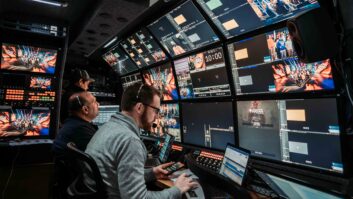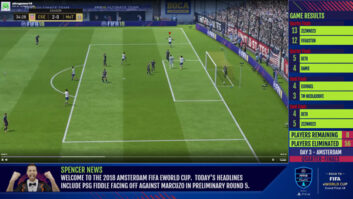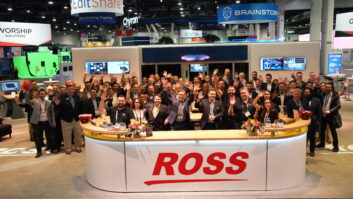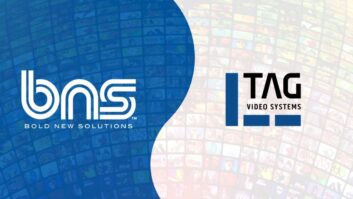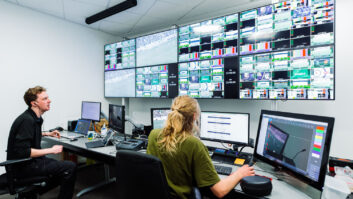The UK studio operations of gaming network ESL are hidden away on a quiet and inconspicuous industrial park in Leicester. With room for several teams of gamers, commentators and an audience of up to 100 fans. The largest studio broadcasts 3-4 times a week and has incorporated an increasing amount of broadcast kit – most recently a range of products from Ross Video.
ESL’s UK studio, one of 15 around the world, is similar to their facility in Cologne, Germany. Both use Ross’s Carbonite Black production switcher and all on-screen graphics are provided by the Ross XPression platform. Ross NK series routers and DashBoard, Ross Video’s open source control interface, help complete the system.
Before going to Ross, ESL had been using ‘studio in a box’ type technology, but felt the products didn’t deliver the production values they were looking for. The company were seeking scalable results and products that would allow them to be more creative without pushing up costs.
“We made the jump to Ross in order to simplify and improve our workflow”, says Sam Deans, ESL UK’s production director. “I’ve worked in broadcast for a number of years, and I understand the value and importance of high production values. We wanted to take a step up from our previous equipment and create slicker and more professional-looking broadcasts, but also wanted to ensure that these broadcasts could be easily and consistently run by the people on the team who aren’t broadcast engineers. This is where DashBoard has been a lifesaver for us. We worked with Ross to create customised DashBoard panels that enable anyone on the team to manage one of our broadcasts. We are not a huge team so we all need to be flexible and multitask.”
These people are highly tuned to creative possibilities, and they act in a way that is faster and more nimble than many of the broadcasters we deal with
“We’ve been delighted at how scalable the system is”, continues Deans, “and we’re already thinking about how we might introduce augmented reality into our broadcasts. The level of technical support from Ross has been first-class and has given us great confidence to expand and build on our system.”
“As an industry we expect e-sports to be worth around $1000 million within two years”, says ESL UK’s managing director, James Dean. “We’re not a traditional broadcaster, however the expectations of production values are ever increasing, in line with the size of the industry, currently serving over 150 million viewers.”
Ross Video’s marketing manager for EMEA, Stuart Russell, believes e-sports are an untapped opportunity for broadcasters and suppliers.
“We’ve not done a huge amount in the gaming and e-sports market but it’s definitely an exciting and growing vertical,” says Russell. “We’ve also got a relationship in place with the Future Group in Norway who are currently piloting a game show format that relies on Ross Virtual Solutions technology. We’ve got high hopes for it in terms of a new level of interactivity and people being able to play along with the gameshow on their second screens. It’s different from e-sports, but shows how virtual studio technology is been used to increase audience engagement.”
Russell doesn’t see the demand for e-sports – and its interest in broadcast tech – waning any time soon.
“Esports may have started out small and niche but it has exploded in growth and is now worth an incredible amount of money as an industry. It attracts quite a young demographic and still has an underground vibe, but more ‘traditional’ broadcasters cannot have failed to notice its popularity. I think all major broadcasters around Europe are waging an ongoing battle to maintain audience share and to keep teenagers and younger adults engaged in the face of increasing fragmentation. I’m not saying that Esports is the next big thing to help do that but…”
There is still a huge cultural difference between e-sports and traditional sportscasting, however. E-sports began in the online and gaming world – IP centric and endlessly iterative. The two sides have much to teach each other.
“Most of the people we have met in e-sports have not come from a traditional broadcast engineering background,” says Russell. “That’s good because these people are highly tuned to creative possibilities, and they act in a way that is faster and more nimble than many of the broadcasters we deal with. They don’t always use the same vocabulary as our other customers, so there are always some challenges to overcome, but our ability to create customised DashBoard panels for their system has been a big bonus insofar as we can allow the customer to dictate the look and feel of the control interface.
“ESL were looking to improve their overall production values and bring more creative content to the screen. In this sense, they’re no different to a BBC or a Canal+, and they want to explore what is possible. That said, they also know their audience has a surfeit of content choices, so they’ve challenged us to think about how our graphics solution can be used in different ways – they’re not coming at things from a traditional workflow perspective and that’s been an extremely refreshing experience that may well shape some of our product development.”
Read our e-sports feature in the August issue of TV Technology Europe
